Jump Ahead To
As the isekai genre have taken over the anime scene, ChasingAnime has compiled some of the best 36 isekai anime for you to watch right now.
Isekai Definition: What is Isekai?
Sekai (Japanese: 世界) means “World” in Japanese. Isekai (異世界) translates to a “Different World”.
So, what does Isekai mean in anime?
Isekai belongs to a subgenre of fantasy anime. A character usually starts out in our current world and ends up being in another world, usually in a magical realm. It could be any type of world. It could be by being murdered by truck kun, Japan’s most prolific serial killer. The reverse (although less common), can hold true too. Anime shows like The Devil is a Part-timer! (はたらく魔王さま! Hataraku Maou-sama!) is one such example where Satan adjusts to life in Tokyo, taking on a part-time job at ‘McDonalds’ and learning human / Japanese culture.
Contrarily to popular beliefs, although the anime community saw a huge boom isekai anime recently, the first isekai anime began long ago in February 1983. Its name is Aura Battler Dunbine (聖戦士ダンバイン Seisenshi Danbain). TL;DR, it is a story about a man transported to another dimension to battle evil. There have been major hits like the likes of Inuyasha (犬夜叉) and Zero no Tsukaima (ゼロの使い魔).
Only in recent years, however, there is been growing popularity with 2 to 3 isekai anime each season. Previously, there have been many instances where the isekai genre surge and declined. Unfortunately, none has seen an explosive increase after the anime Sword Art Online (a.k.a. SAO). Gigguk did a pretty cool round-up of isekai anime history that you can check out here.
What is the best isekai anime?
We have been watching anime since we were kids. We know that deciding on the best isekai anime series with our friends always end up in heated discussions, until now. It has become a big genre and it still growing. Let’s dive right in and see if you agree with us.
The short answer for the best isekai anime is Spirited Away by Studio Ghibli. According to MAL, it has the highest rating of 8.90.
Since isekai is now a very big genre, ChasingAnime has shortlisted the top 30 (33, actually) isekai anime series into a list to help you decide on your next isekai adventure. We focused on sharing the key highlights in each isekai series and the reasons why you would enjoy watching it (or not).
Disclaimer: We do not share boring lengthy summaries of each series – you can go to MAL for that.
Bonus: We have with us a super helpful flowchart to help you decide what isekai anime to watch next, customized based on your preference. Read on to find out.
1. That Time I Got Reincarnated as a Slime (Tensei Shitara Suraimu Datta Ken)
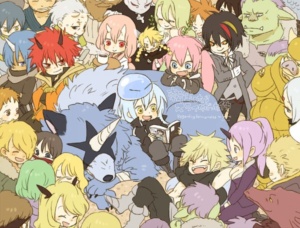
MAL Rating: 8.15
That time I got reincarnated as a slime is a show that I’m very excited about. In typical isekai fashion the main character dies. He gets reincarnated as a slime with his memories intact.
But as a slime he lost all 5 human senses so he can’t even see the things around the cave. He has to grope around in his slime body to make sense of the world he is in. That is where he met the dragon Veldora by chance. This fateful meeting sets everything in motion.
The anime follows the light novel pretty closely, so you get to see Rimuru’s adventure at almost every step of the way without worrying about missing much of the action.
Being a slime, as we are all too familiar, have everyone assumed that you are the lowest lifeform in the food chain. You can imagine the disastrous and almost comical situations that Rimuru lands himself him. Usually, it’s not actually his fault but simply because he is a slime.
And there’s something to look forward to.
2. Sword Art Online (SAO, Sōdo Āto Onrain)
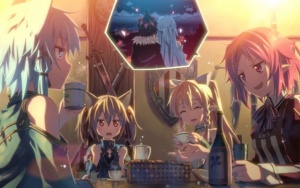
MAL Rating: 7.49
It started when you realized that you are trapped in the world’s first virtual MMORPG, unable to log out. The breathtaking views the game offers seemed to fade away. The fear of dying replaces the scenario. Players soon learn that dying in the game means death in real life too. The only way out of this survival game is to beat the 100th level floor boss.
No revivals, no resurrections, and no second chances. It’s easy to be glued to such a premise, and such is the reason SAO got so immensely popular. The anime community regards it as the isekai anime that started it all.
How many people actually died in SAO? How did the SAO creators kill off the many players that died in the game?
The last I recalled was over 3800 deaths, with over half occurring in the first month of the game. To play the game, you wear a helmet looking device called a nerve gear as shown.
The device brings your consciousness and your 5 senses into the game, where you can play the game as if in real life. The SAO creators use this device to send an electrical impulse to fry their brains, killing them.
This anime has some of the best fight scenes ever and reminds you of your childhood games like Maplestory and Minecraft.
A definite must-watch.
3. The Rising of the Shield Hero (Tate no Yuusha no Nariagari)

MAL Rating: 8.10
Different. Just different – that’s Tate no Yuusha for you. Tate no Yuusha follows where Naofumi got summoned from a book he opened in the library to save the world.
Typically, in an isekai anime, the main character is usually a relatable average person like you. They then get transported into another world with its memories intact. These memories grant them an overwhelming advantage in this new world.
Sounds familiar so far? Here’s where things change, however. First, he got stuck with a class that can only hold a shield as its only weapon, effectively resulting in a type of hero that can only defend in battle.
How shitty is that? Just when you think that nothing else can go wrong, he next got betrayed and swindled of his money within a day. The very country that summoned him accused him of false crimes. No one would listen to his defense.
From that point on he lost his trust in humanity and rely solely on himself to save the ‘rotten’ world as it is the only way he can return home.
As the story progresses, he slowly but surely and unintentionally earns the trust of those he has helped. It is simply heartwarming to watch him overcome adversity and learn to trust and rely on the people around him.
4. KonoSuba: God’s Blessing On This Wonderful World! (Kono Subarashii Sekai ni Shukufuku o!)

MAL Rating: 8.18
In this fun anime adapted from a light novel, Kazuma was a hikikomori (shut-in). On his way to buy a game, he pushed a girl away from an oncoming truck. He thought that he at least died a meaningful death. When he ‘awoke’, the obnoxious water goddess (aqua) showed him the reality that he simply peed his pants and died from shock.
Aqua gave Kazuma 2 choices: continue to heaven, or start afresh with a new life in a fantasy realm, with a mission to defeat a demon king and become a hero. When he chose the latter, he was granted the right to bring any one thing of his choosing with him. What did you think he chose?
You guessed it, he chose Aqua. And Aqua turns out to be a completely useless burden. Watch how he lives his 2nd life, perhaps with regrets. This comedy isekai would surely lighten the mood and make you laugh your ass out numerous times.
5. No Game No Life (Nō Gēmu Nō Raifu)

MAL Rating: 8.34
NGNL has the inseparable combination of a tall, pasty older onii-san and a messy-haired cute imouto. It has become one of the strengths, and running gags, of this next entry in the list. Make them geniuses with slightly different affinities, each being the half of the world’s best gamer. Then reinforce them as a single, unstoppable character – now you have an anime series worth watching.
No Game No Life focuses on siblings Sora and Shiro. Together, they comprise the unbeatable player known only as『 』(Kūhaku, or Blank). Actually, they are shut-in NEETs who goes to an alternate world. They get teleported immediately after winning an anonymous invitation to an online game of chess. In Disboard, games govern the laws of the land, This includes including the lives of the sixteen races which live in it. More than simply earning treasures or ruling kingdoms, they aim to conquer the world and make all races bow to their command.

What makes this series stand out is that it always makes use of the idea that they are a lot more than the sum of their parts. Shiro, the younger sister, is a certified genius with unbelievable analytical and computational skills. What she lacks, however, is in dealing with the human aspect of playing games – reading social and psychological clues. This is where Sora comes in. While he is intelligent in his own right, though incomparable to Shiro, he is charismatic and eloquent in dealing with opponents. Together, as Blank, they remain unbeatable as they raze their way through the races in Disboard.

It covers a lot of topics that make it almost immediately endearing to the gaming community. The apparent boredom that eats away at the best and smartest of us. The seemingly unstoppable hermetic lifestyle and the disconnect from everyone else. In the series, the siblings find comfort and contentment with each other. They find each other at a similar wavelength and cover for each other’s weaknesses.

On a lighter note, it is a good testament to show naysayers the benefits of playing video games. Sora was able to manage all the affairs of the human kingdom. He settled issues from finance and taxation to agriculture thanks to strategy games like Civilization. On the other hand, it also presents practical applications of mathematics and science. The series uses gaming concepts like card counting and cold reading. These all help drive the siblings’ belief and trust that they stand a chance against the stronger races. It exemplifies humanity’s limitless potential for learning.

6. Jobless Reincarnation: I Will Seriously Try If I Go To Another World (Mushoku Tensei: Isekai Ittara Honki Dasu)
MAL Rating: 7.98
We have added a yet-unreleased isekai anime just to throw a wrench in the list and as a show of our confidence in this work written by Rifujin na Magonote and later illustrated as a manga by Yuka Fujikawa.
It opens with a 34-year-old NEET (Not in Education, Employment, or Training). His relatives unceremoniously evicted him from his own house during his parents’ funeral. He realizes that his life has been miserable and a waste. Asking to start over, he tries to save a group of students from a speeding truck and manages to save one before he dies on the street.
He then wakes up in the body of a baby, Rudeus Greyray. Even more amazing, he has all his knowledge and memories from his former life. Realizing he is now in a fantasy land of sword and sorcery, he applies his knowledge and becomes extremely adept in magic. He gets entangled with a Human-God and goes on an adventure, takes a wife, and receives a visit from his future self a la Flash in Flashpoint.
When it comes later this year, a large audience will be waiting. It starts off heavy, with the NEET main being fat and quite unsightly. This type of main is rarely represented, which makes it more relatable and realistic. Regardless of his appearance, his self-reflection definitely pulls some heartstrings. It asks what life must be in order to be defined as meaningful. This is only the first half of the manga’s Chapter 1.
Even more, the general consensus is that the manga has streamlined the light novels. The source of the source materials further explains all the nuances in Mushoku Tensei’s world. If the manga managed to draw a lot of attention, even with the missing parts, we can definitely expect the anime to do the same.
7. Overlord (Ōbārōdo)

MAL Rating: 8.05
Looking at it closely, Overlord opens with a rather sad backstory. After 12 years, Yggdrasil is set to shut down its game servers. The last player and the leader of the strongest guild in the game, Momonga, stayed in. The guild leader painfully watched as the last of his comrades log out ahead of the server shutdown. Though it is a guild whose members are working adults and functioning members of society, it is still sad to see Momonga get left behind.

On the other hand, he keeps their memories alive in a couple of ways. His main weapon, a staff with a seven-headed serpent, is a special item they forged together through various quests. Also, he now works together with their base’s floor guardians. These guardians are former NPCs whose personalities are based on their creators, his former guildmates.
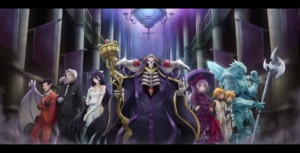
Moreover, as a person trapped in the game-world, imagine if the usual traits associated with the race you chose to play as starts manifesting. The titular Overlord faces the risk of being an actual undead. He is now starting to feel very cold and has started lacking moral and emotional setbacks.

An overarching theme is Momonga’s protectiveness over his friends’ legacy. He still deals with the loss of his friends, now being trapped alone in an all-powerful avatar. While it is set in 2138, the scene it paints is very much applicable today. Momonga has become attached to his guild and its remnants, even though they are only friends in-game. Gaming has given most people a place to belong to, and the titular Overlord is no exception.

The series draws another strength by starting out with an unbelievably strong character. Having him face worthy enemies later is suspenseful and curious in itself. Also, it begs the question mankind always has – if you have near-limitless powers, what would you do with it?
8. The Devil Is a Part-Timer! (Hataraku Maou-sama!)

MAL Rating: 7.92
This series is a good example of how flexible anime storytelling can be. Hataraku Maoh-sama starts with a serious high-fantasy war. The Demon Lord Satan is close to conquering their world of Ente Isla. In the last lap, however, the heroine launches a surprise attack forcing him and his general to seek refuge in a different world.
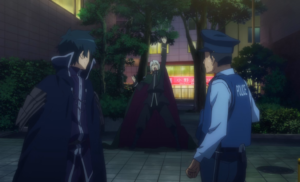
Here is where it takes a complete 180° from serious action to hilarious comedy. Satan and Alciel then tries to live in Tokyo in their human forms. They try to find an apartment and just survive every day. It creates its own take on certain tropes where characters from a fantasy world arrive at our own, magic-less world. An example is when Alciel, fresh from Ente Isla, tries to perform a complicated magic spell. Instead of summoning lightning or opening a portal, a taxi cab coincidentally stops in front of him. Also, this anime is iconic because the part-timing demon lord works at MgRonald’s. Read that again.

Of course, the heroine Emilia follows the duo and goes through the same experience. Satan’s archenemy ends up as a call center agent instead of a fast-food crew. She starts out in pursuit of the escaped Demon Lord and eventually accepts working together with his target. The anime makes a point of examining her difficulty in accepting this decision. She gradually learns that Satan’s kindness and concern are genuine. While they learn to compromise and work together, the series makes sure that the audience does not forget just how powerful the Demon Lord is.

Even as he sinks into a competitive employee and a good friend, the fact that he’s still the Demon Lord presents itself nicely. Every once in a while, enemies come to Japan from Ente Isla. What makes it more interesting though, is that it includes villains everywhere. There are foes from the demons’ side as well as the heroes’ side. Everyone has their own reasons for doing so, keeping the story coherent and interesting.

The challenges range from replacing a damaged bicycle and getting sick without insurance to fighting a demon general and an archangel. The Devil is a Part-Timer seamlessly moves through its narrative without feeling cliched or exaggerated. Too bad it leaves most fans hungry for more, running for only 13 episodes. Still, it is one of those gems that gets you hooked and leaves abruptly with a weird sense of satisfaction.
9. Gate: Thus the JSDF Fought There! (Gate Jieitai Kano Chi Nite, Kaku Tatakaeri)

MAL Rating: 7.83
As soon as it starts, it makes the case that being an otaku is not limited to shut-ins, geeks, and NEETs. Here we have a 33-year-old decorated soldier pursuing his hobby when a portal to another world opens smack in the heart of Ginza. With resentment, Itami Youji assists in evacuating citizens. Later on, he serves as a part of the Japan Self Defense Force (JSDF, or Jieitai).

While Japan in the series aims to create a meaningful peace treaty, one can’t help that it is nothing more than a formality in the face of an unbeatable enemy. On one hand, you have the JSDF with automatic rifles, tanks, and helicopters trained in both conventional and unconventional warfare. On the other hand, you have a clearly medieval army (and look like them here) without ranged projectiles, bulletproof vests, or the sense to have another strategy aside from the forward charge.

The story drops bits of info about the protagonist as it progresses. TL;DR: he is basically the Japanese John Wick with an excessive love for anime and manga merch. We get the standard fare of blonde elven girls, a blue-haired mage, and a goth loli shinigami. The cast and the plot are made even funnier with the show’s self-awareness with tropes of the isekai genre.

Moreover, the series shoots not-so-subtle commentaries on Japan, its view on world powers US, Russia, and China, and even the internal strife holding back the full might and glory of the Jieitai. But these are topics for another article and most of them are lost in the comedy and action anyway.

However, the series shines brighter when it explores the troubles of human morality when pitted against politics and bureaucracy. Even the season 2 opening theme captures the conflict perfectly as it opens to lyrics. “It’s impossible to do the right thing all the time.” For a series routinely judged as right-wing propaganda, it does refresh viewers with a universal lesson we can all agree on – we should do what we believe in our heart is the right thing to do.
10. How NOT to Summon a Demon Lord (Isekai Maō to Shōkan Shōjo no Dorei Majutsu)

MAL Rating: 7.19
In the isekai genre alone, some of the most commonly-used tropes include the video game world that uses hikikomori (shut-in) IRL protagonists and those that feature overpowered main characters. Overlord uses both as a stepping stone in analyzing the morality that comes with near-infinite power. Sword Art Online and .hack//sign uses the shut-in setup to create cynical, brooding characters with complex backstories.
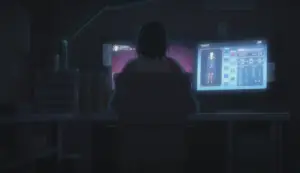
Then there’s Takuma Sakamoto, another hikikomori mysteriously summoned to the world of Cross Reverie in the form of his gaming avatar – the unbeatable Demon Lord Diablo. He’s awkward and anxious and shy but decides to keep his worries inside and act as a true Demon Lord. It gives birth to most of the gags in the series – being frighteningly powerful outside, but with a quivering nerd inside. The internal dialogue between the awkward Takuma and the overbearing Diablo creates one of the best things in this anime.

Though it lacks a thought-provoking storyline and a suspenseful conflict, it makes up for it with huge amounts of comedy and over-the-top fanservice. While technically not a harem anime, it features almost every female character archetype in the dere spectrum (compiled neatly in this collection set). The ecchi scenes in every sequence do not really get in the way of the storytelling. But be careful watching it in public, you wouldn’t want to give others a wrong idea of what it’s about.

For the overpowered Diablo, most fights start with a foregone conclusion. The anime still takes the time to give most opponents the ominous casting time and animate it well, like the iconic Kamehameha or Kogure’s episode-long three-pointer in Slam Dunk. But of course, it ends anticlimactically with a simple wave or a flick of a finger. In How Not to Summon, it gives the same One Punch Man treatment to the enemies but with less gore and more comedy.

Every once in a while though, a stronger-than-usual opponent comes across. Where his Demon Lord powers are usually stopped to a halt, his gamer side strategizes and lays out pretty why-didn’t-I-think-of-that approaches. On a positive note, it plays out while maintaining that fun internal dialogue between the anxious kid inside and the Demon Lord outside.

11. Re:Zero − Starting Life in Another World (Re: Zero Kara Hajimeru Isekai Seikatsu)

MAL Rating: 8.34
Isekai anime now come and go, but few leave their mark as Re: Zero does. It will catch you off guard first when it lays down the premise and second, as it progresses through the story- basically every episode.

Re: Zero centers on Natsuki Subaru, yet another hikikomori transported into another world. On his first day, he encounters trouble trying to help a silver-haired lady find her stolen insignia. Their short-lived travel ends when they find the insignia and they both die. The end.

Except that it’s not. Subaru returns to his first moment in the other world, relieves most of the same event and promptly dies again. And again. Like in Edge of Tomorrow (or All You Need is Kill, for light novel fans), at least, until he enlists the help of Reinhard.

The artwork in Re: Zero complements the fantasy world it is set in, thanks to its colorful character designs. Story-wise, it offers a fresh take on the isekai genre with the lighthearted fish-out-of-water comedy we initially find with Subaru. While we all understand early on that Subaru returns to a save point upon death, the anime keeps his most deaths suspenseful, messy and violent, reminding us of Mirai Nikki and School Days.

Poisoning: check
Freezing, while laughing: check.
It’s what keeps everyone on the edge of their seats. Subaru fights for his life and does not take it for granted. It reaches a crescendo when he finally breaks down from dying again and again. Rem responded by being the last ray of hope in a world where everything felt wrong. This exchange cemented this series’ position among the best anime in recent years, with the conflict captured in the lines below:

If you haven’t seen Re: Zero at this point, it’s no longer a question of whether you should watch it or not. It’s a question of when, and the answer is now. It’s a serious story with both cute and cool characters, breathtaking suspense, and an impressively human protagonist in the midst of all this magic and action.

12. Log Horizon (Rogu Horaizun)

MAL Rating: 8.05
Before you skip this entry and dismiss it as a cheap SAO knockoff, know that Log Horizon takes the effort to pull its audience to the world of MMORPGs (Massively Multiplayer Online Role-Playing Games). Relatable gaming elements are prominently featured in almost every episode. Get ready to feel in-game with the graphical user interface, friend lists and voice chats, and the importance of guilds and parties.
Unlike SAO, death in the game does not equate to death in real life. However, the players of Elder Tale soon realize that while they are basically immortal in this world, they lose memories from their former lives every time they respawn at the nearest Cathedral. It is impossible to map out which memories are lost, and how much. They only know that every time a player dies, the lost memories accumulate.
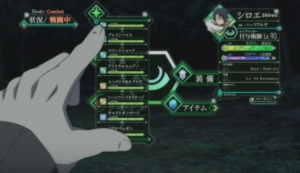
Perhaps the powers-that-be governing The Novosphere Pioneers intend to wipe out everyone’s memories from before the game. Something, or someone, might be looking to trap the gamers and make them no different than the People of the Land. In the new world, these former NPCs now have their own backstories, memories, personalities, and agendas which make things a lot more complex.

aminoapps
At the center of it all is a socially awkward player Shiroe. He finds his old comrades and faces the in-game world which is not like the video game they once knew. The one known as the Villain in Glasses is just one of the millions trapped in the game. He is not a chosen one, he was not a beta tester, nothing. His years of experience made him famously tough, but equally distrusting of the people around him. He grows, however, and learns that the guild system he once detested is the same system he needs in order to protect his new world.
It is a lighthearted critic of the culture of escapism established with the growth of MMORPGs. Here is a world where you get to be who you want to be. You can defy the laws of physics and more importantly, the laws of society. However, in a world of anonymity, the main character still draws the importance of empathy and community if they were to succeed in the game, or life, as they have overlapped and basically rolled into one.
13. The Saga of Tanya The Evil (Youjo Senki)
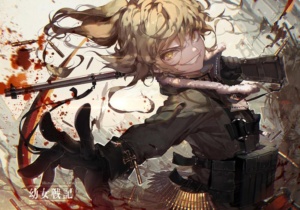
MAL Rating: 8.10
Some attempts to break free from the standard isekai, where a good-natured quirky protagonist is sent to another world and is soon tasked to save it, have given us classics like Overlord. If you’re a fan of villainous mains à la Yagami Light or Momonga, Tanya von Degurechaff is a good addition to the roster.

Even his colleagues in what appears to be the magical equivalent of WWII Germany describe Tanya as a monster in the form of a little girl. True enough, he used to be an atheist salaryman who shows no regard for others in the name of efficiency.
He was to his death at the train station by a subordinate he fired earlier. In his last moments, he was brought before “God,” known as Being X. Remaining arrogant even in the face of death, he still keeps on insulting and questioning Being X. He was then sent to the other world with the condition that if he dies again, he will no longer be reincarnated and will suffer in hell for eternity.

There are a lot of reasons to start watching this show, especially if you’ve come across some gut-wrenching characters over the years. It has amazing magic dogfights in mid-air. There are some thought-provoking dialogue. And there are other characters to watch out for aside from Tanya.
Her strict adherence to the rules as a soldier makes her appear patriotic. The truth is, however, she is just committed to her job so she could retire and live an easy life.
The important takeaway here is given early in the story – mankind has strayed away from God and has lost compassion for fellow men. Putting the question of whether God exists aside, it does drive the point of how in our attempt for a better life, we tend to trample over other people. Tanya is the stretch, but she does come around and learn over the series.
14. Drifters (Dorifutāzu)

MAL Rating: 8.01
Quick fact: Drifters, the manga by Kouta Hirano and animated by Hoods Drifters Studio, takes this genre and turns it on its head multiple times.
Characters based on actual, historical figures are respectfully dragged from their own timelines into an alternate world. Here they are pitted in a war filled with creatures from fantasy and literature – elves, hobbits, dwarves, and dragons. Dragons.
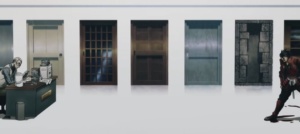
In this world, Drifters are summoned to help humans fight against the Ends. The Ends are magic-capable anti-heroes who intend to bring about the end of this world and the other. Both sides are filled with colorful historical characters, turning the genre as it mixes what history perceives as heroes and villains.
On the side of the saviors are characters like the warlord Oda Nobunaga and outlaws Butch Cassidy and the Sundance Kid. You also get to see World War II ace pilot Naoshi Kanno – with his signature Kawanishi N1K. This is pure awesomeness at work.

The Ends, on the other hand, include a Hijikata Toshizo who can summon the ghost of his Shinsengumi comrades, a pyrokinetic Joan of Arc and her polar opposite, the cryokinetic Anastasia Romanova.
Also, the animation style fits in showing gritty and bloody diorama of war. Even Toyohisa appears to be in a constant state of battle frenzy. Moreover, it attempts to present its characters as realistic as possible, if we were to turn to history for context. Yasu no Yoichi, for example, is a calm and calculating archer who never misses a shot. Surprisingly, he has to deal with PTSD due to the Gempei War he participated in at a young age. Joan of Arc, on the other hand, resents humankind and uses the very flames that burned her at the stake as her newfound power.

For Drifters, there are no philosophical or emotional nuggets. It focuses on the ambiguity of war mixed with a good dose of badassery. Moreover, a lot of details remain unrevealed in the anime series.
Lastly, see if this last bit will convince you to see Drifters. The Black King, the leader of the Ends, is a silhouette wearing white robes, multiplies food, heals just about everyone, and has hole wounds in both of his hands. Whether the Big Bad in this series is actually Jesus Christ remains to be seen.

15. Spirited Away (Sen to Chihiro no Kamikakushi)

MAL Rating: 8.90
This coming-of-age film is also Japan’s highest-grossing film, and deservedly so. It tells of an Alice in Wonderland-like story, but with gods taking a break in an otherworldly resort as a break from their duties on earth. At the center of it all is a ten-year-old Chihiro who finds her parents turned into pigs after eating at an unattended stall.

What follows is a young girl’s quest to restore her parents and get back home. The entire story commences using the signature experimental animation techniques fans have known and loved from other works by Studio Ghibli, most notably its predecessor, Princess Mononoke. While it is not a visual spectacle with sharp details and rich CGI, the hand-drawn designs only use computer software to create smooth motion and transition.
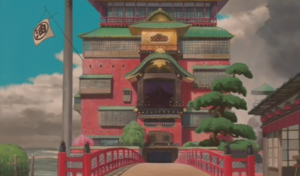
Chihiro representing childhood is one of the greatest elements in this movie. She captures the feeling of loss and helplessness. Any child who has been separated from his or her parents definitely know how weird everyone else looks like, aside from mom and dad. The anime takes it through a creative visual filter that turns strangers into gods and monsters of all shapes and sizes. It makes everyone relate to the feeling of a kid suddenly not knowing where to go.

Her journey, regardless of what countless fan theories might imply, is one of growth and maturity – even if sometimes pushed through by circumstance. In the anime, it was her parents’ choice and her curiosity which sets the events of the film in motion. Further in the film, Yubaba and No-Face are ancient creatures (look at the wrinkles and the transparency, telltale signs of age) who further push Chihiro towards growth, even if it sometimes feels uncomfortable and dangerous.

In the end, with help from a friend, Chihiro returns home and we find a happy ever after. While watching the curtains close on the movie, the audience gets a sigh of relief. However, as if by some magic, you can rewatch Spirited Away, like most Ghibli classics, over and over again. Every time we watch it, we know how the story will go and yet, a new layer seems to unfold, like turning a kaleidoscope.
16. Isekai Quartet (Isekai Karutetto)

MAL Rating: 7.58
Do you know how most anime series include a short omake, or bonus, at the end of every episode? Either to explain events in the main series, preview the next episode, or to poke fun while breaking the fourth wall, chibi characters give a cute spin to our beloved series. Think about an entire anime series with nothing but those chibi characters, now imagine those characters coming from different anime series a la crossover. That is the treat Isekai Quartet brings, and thus, taking the isekai genre full circle.

Isekai Quartet is basically the anime equivalent of Marvel’s The Avengers. Unlike The Avengers, everyone here is in chibi form and the setting is a high school. By pressing a magic button, characters from different worlds are taken into a new isekai where fun and hilarity ensues. Also, all the characters featured are from Kadokawa properties Overlord, KonoSuba, Re: Zero, and The Saga of Tanya the Evil.

If you’re planning to see Isekai Quartet, you’re better off not expecting any serious storyline or development in Isekai Quartet. On the other hand, you’re not required to be a fan or to know everything from the source series. An added treat: Rising of the Shield Hero comes in season two.

For some fans, it’s the answer to most what-ifs in the Kadokawa roster of quality anime: what happens if Ainz, Subaru, and Kazuma meet each other? Or even better, what if Tanya still pissed off from a god (Being X) meets Aqua, a self-proclaimed goddess. These are fun to ponder, which makes it even more fun to watch. In the series, a strong personality such as Tanya looks good working together with Aqua, and they even go to detention together.

It is basically a large omake series in its 12-episode run, which makes it perfect for those who are looking for a lighter break from watching serious isekai anime. It is safe to say that Kadokawa knows what they are doing, seeing as how Season 1 received positive reception. What makes it click for most fans is how different they are, yet somehow, they work together and look cool in the process.
17. Restaurant To Another World (Isekai Shokudou)

MAL Rating: 7.38
Most of the isekai anime are adventure-based where the hero from another world goes on a quest or a mission. At first glance, it makes sense because these have always been the purpose of places where the laws of physics don’t apply. Relatability is presented through the characters’ personalities and struggles. Maybe that explains why there are few non-adventure isekai anime.

Isekai Shokudou does it differently and does it well. It is a slice of life anime focusing on food, things you normally don’t associate with isekai. The Western Restaurant Nekoya sits nonchalantly in a Tokyo shopping district. However, as it closes in Tokyo on Saturdays, it opens up to a fantasy world where hungry patrons include werebeasts, elves, dragons, and the like. The chef is not overpowered, has no magical artifacts, he’s just good at doing Western and Japanese cuisines.

While it is technically a cooking anime, it lacks the over-the-top reaction you might see in Shokugeki no Soma or Yakitate!! Japan. It does not even have the flying sliced ingredients or shining, shimmering fried rice from older entries such as Cooking Master Boy. To leave you slightly curious, the meals served in the series include common foods like beef stew and tonkatsu and yet you will stay.

But still, it manages to shine as a quality anime by telling the timeless lessons on food, and here it grabs the fans’ attention and approval. For most of us working or studying the entire day and left drained, a plate of good food is a slice of heaven. The world-building excels by focusing more on the story of the customers and less on the chef, who is ambiguously called Tenshu (Master).
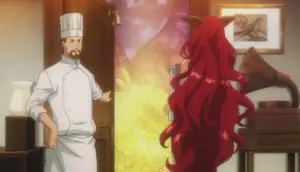
Perhaps the largest trap in the influx of works in the isekai genre is sticking to tried and tested formula. Countless anime goes like this: a person is drawn from Japan to a fantasy place and they explore and maybe save the other world. In a genre flooded with “boy goes out into the world”, Isekai Shokudou does the opposite: the world (or worlds) comes into the Nekoya.
18. The Boy and The Beast (Bakemono no Ko)

MAL Rating: 8.41
This work by Studio Chizu, and directed by Mamoru Hosoda (The Girl Who Leapt Through Time, Summer Wars), is a visually-compelling story of acceptance and redemption. It opens with a picture-perfect Shibuya crossing, with the neon lights and the flow of people. People who have been there might’ve seen themselves in the restaurants and alleyways brought to life.

In the middle of the busy streets is the runaway Ren, who had difficulty accepting the loss of his mother and the disappearance of his father. Following two hooded figures, he finds himself lost in Juutengai, a kingdom of beast monster people and becomes the disciple of the dog-bear-like Kumatetsu, who is a candidate for the next Grandmaster.
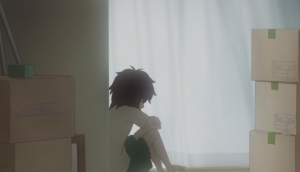
What follows is a fast-paced introduction of characters and establishing the master- pupil relationship. It is reminiscent of The Karate Kid (the Jackie Chan one), even with the montage of interposed training and household chores. The studio evidently took the time to choreograph and animate the fight scenes well. Kumatetsu even performed the Ali Shuffle in front of the lion-boar Iouzen (who has the air of respect and majesty as Arslan, Narnia fans) during their first showdown

Even the side characters do well in this must-see flick, exemplified by the usually loud and energetic Tatara and the calm straight-guy (as in comedy) Hyakuushubou. They also foil the tension between the two main characters. Even the goofy old master archetype we see in Master Oogway or Master Roshi.

But perhaps the part that stays with us after watching The Boy and the Beast lies in its climax filled with self-sacrifice and compassion. Just as Ren (or Kyuuta) lays down his life to subdue the big bad, Kumatetsu transformed himself into a symbolic sword which fills the void inside Ren.
Overall, the flaws in the character allow us to see ourselves in them and hope that we find the same companionship to fill our own gaps. The Boy and The Beast will make you gasp at the scenic places, cheer in support of the lovable cast, and maybe shed a tear or two as they find a way to always be together in the end.

19. Digimon Adventures (Dejimon Adobenchā)

MAL Rating: 7.86
Let’s set this straight, Digimon started out rough because it was being shelved as a Pokemon knockoff – monsters paired with human partners and throwing Digi- before every word instead of the earlier Poke- prefix. But Digital Monsters would set out into something else and have a dedicated fanbase waiting for the latest installment of the franchise twenty years later.

Seven Japanese children at a summer camp were transported inside the Digital World – a parallel world interlinked with our Internet and telecommunication networks. They meet and befriend several digital monsters and each receives a Digivice – a cooler version of the ubiquitous (at the time) Tamagotchi. They go on adventures and save both worlds.
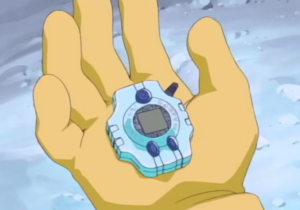
What made this appealing for children back then is that the DigiDestined kids (see, Digi everywhere, told you) are relatable. You have a reckless leader archetype and the level-headed second, even the straight honor student, and the computer nerd. These are not warriors or mages, these are ordinary kids putting their trust in their friends.

Instead of evolving their partners with battles or rare candies, the growth of the kids’ Digimons is tied to the destined kids themselves. When they break out from their shells, such as when Taichi decides to stand up to an overwhelming enemy, his Crest of Courage activates. Being a kid in the late 90s, you know something serious is about to go down when you hear the intro to Ayumi’s Brave Heart song.

As an anime forever accused as a knockoff, it stepped away from Nintendo’s super-franchise by letting the characters grow with the kids who watched them. While Ash Ketchum remained a ten-year-old since he started out from Kanto up to Alola 19 years later, these first DigiDestined kids grew, with Taichi and the others leading the next generation of the chosen ones. Its latest entry, Digimon Adventures: The Last Evolution Kizuna, shows them all grown up and culminating in a final farewell to the first DigiDestined, and to their fans forever.
20. The Vision of Escaflowne (Tenkū no Esukafurōne)

MAL Rating: 7.75
The Vision of Escaflowne follows in the vein of Fushigi Yuugi and Twelve Kingdoms. Escaflowne centers on Hitomi Kanzaki who was transported to Gaea – an isekai where the Earth and Moon can be seen from the sky.

Hitomi then gains the power to see the future and uses it to help Van stop the Zaibach Empire. As Escaflowne progresses, the audience learns more about the world and the people in it. Still, it does so in a smooth and flowing manner instead of using tiresome exposition scenes.

As an adventure and isekai anime, it fills its story with giant mechs and well-choreographed fight scenes between them. The Guymelefs are some of the finest mechs, being large proud robots with heavy medieval designs – less like mobile suits and more like Knightmare Frames from Code Geass.

On the other hand, the series also delivers a well-crafted romance story. A love triangle tears Hitomi between the king and the first knight from another kingdom. It was treated carefully as an inevitable effect of their actions. It did not force anyone to act irrationally, a common pitfall we find in the Arthurian Legend of Lancelot and Guinivere and slightly in Fushigi Yuugi with Miaka and Hotohori. Hitomi, Van, and Allen (Van Halen, get it?) find a nice resolution to this love bug issue.

The Vision of Escaflowne has been the entry anime for most people who want to start with anime but are quite overwhelmed with infinite options available. Awesome mech battles underlined by a developing and enduring love story, no wonder it remains on top lists more than 20 years after its first run.

21. .hack//sign

MAL Rating: 7.06
While isekai is itself a wide genre, the classic formula that brought us Log Horizon, Overlord, and Sword Art Online – people trapped inside a video game – trace its roots back to the .hack franchise. To put in today’s words, Tsukasa walked so Kirito, Momonga, and Shiroe could run.

In an alternate 2009 (imagine their “future” was 11 years ago), a computer virus crippled a large part of the Internet, interfering with traffic lights and flight control, leading to large online restrictions. Then a complex backstory leads to the development of The World, where a lot of players will be mind-trapped a-la SAO.
While it was released ten years before Sword Art Online, it does not lag behind its successors. The interface and the feel of being in a fantasy adventure world are mostly present. It has well-rounded characters you will definitely follow and empathize with. Also, its music remains one of the best anime soundtracks there is, even after almost 20 years.

The divisive part in .hack//sign is its slow pacing and multiple layers. Some episodes fly by without any thrill or action, leaving fans of the fast-paced adventure with a sigh.
For fans of mystery and psychology, meanwhile, the leisurely pace works well with its slow and suspenseful reveal of the characters and the world’s background. The story is multi-layered and not everything is as it seems.

Lastly, even though it’s a visually explosive animation, it’s more expository than magic and action. It greatly captures and examines anxiety and sensitive issues such as neglect, physical abuse, and living in dysfunctional families – thrown against the background of a slow-moving and indifferent world. Tsukasa started out a bit of a loner without regard or respect for others. It was eventually revealed that in the real world, Tsukasa is owned by An Shoji, a girl who experienced physical and mental abuse from her father. She found escape by playing The World, even using a male avatar to further distance herself.
More than a fantasy adventure, .hack//sign has the courage and sensitivity to touch difficult matters and tell everyone that it does get better. As An Shoji/ Tsukasa learns to warm up and eventually care for his colleagues Bear, Mimiru, and Subaru, so can we, even if it means finding our place in the digital world.
22. Mysterious Play (Fushigi Yuugi)

MAL Rating: 7.73
Fushigi Yūgi (ふしぎ遊戯), which literally translates to Mysterious Play, was The Isekai before this genre was cool. Its stubborn but well-meaning protagonist, Miaka Yuki, was the quintessential isekai shoujo, or the girl from the other world.

Another pillar to the lasting fame of this Yuu Watase manga is that it is considered as one of the pioneers of the reverse harem trope. A single female lead interacts with a crowd of male supporting characters, seven in this case. From the standard bad boy Tamahome to the regal and elegant Hotohori. It even uses uncommon character tropes at the time, such as the cross-dressing but inhumanely strong Nuriko and the towering yet gentle Mitsukake. Almost all of these seven warriors show affection towards Miaka, as a call of friendship, or duty, or something else.

Miaka magically transports into a definitely-not-China dimension upon reading the Universe of the Four Gods together with her friend and soon-to-be enemy, Yui Hongo. Yui would also go into the alternate world as she attempts to rescue her friend.

This marks the series’ rapid descent into romance and heavy drama territory, away from the rather comedic beginnings of the series. Together with the non-fairytale-ish narrative where people are lost, plus tragic backstories, definitely left heavy hearts on unsuspecting 90s audiences.
Looking at the bigger picture gives us one of the greatest takeaways in the series. While the team seems to be routinely playing into the hands of the villain and slowly losing friends in the process, Miaka kept on fighting. She eventually saves the world and fulfills her role as the Priestess. This returned her and Yui to the real world. As in life, while bad things seem to happen one after the other, we have to keep on fighting and things will get better in time. Nuriko of the Suzaku Seven encapsulates it perfectly, “When bad things happen, don’t give up because the day will come when you look back and laugh at them.”

The storytelling also puts into light the stark contrast between the two friends. Where Miaka was saved from peril, Yui was forced to suffer first before being rescued by Nakago. As Miaka was rash and impulsive, Yui was calm and logical. Imagine if Dorothy from the Wizard of Oz had a sister blown together with her but lands and allies with the Wicked Witch instead?
As a series, it does exceedingly well in dividing the audience near the end. Most critics and audiences are suddenly rooting for the supposed evil final boss. It paints the realities of war and the lasting effects it creates. In our opinion, this is what made even the antagonists, who might appear pure evil at first, relatable and therefore, human.

23. Now and Then, Here and There (Ima, Soko ni Iru Boku)

MAL Rating: 7.71
We feel the need to put this out: Now and Then, Here and There, shortened to NTHT, is not for the weak-hearted. While it was released at the turn of the millennium, 1999- 2000, it employs old-style animation reminiscent of Studio Ghibli classics which unexpectedly works in its post-apocalyptic world.

It follows Shu, a good-natured yet boneheaded kendo fan who finds a weird girl sitting atop a neighboring smokestack. Time then stops and weird mechs similar to Bt’X appears and tries to abduct the girl. Shu tries to stop her abductors and gets transported to her world as a result.

Here is where our prospects go downhill in a crashing, flaming car of our lighthearted expectations. Shu fails to rescue Lala Ru, finds himself in a dried desert world faced with a dying. Even their base, Hellywood, looks like a decrepit Battlecruiser. Worse, he endures torture right off the bat. A lot of things happened but he returns home at the end to his own timeline, safe, but changed.

We decided to drop the good ending as a silver lining to watching it because, boy, is it hard. It is a world in the future where water is a lost treasure. Children form armies that commit atrocities such as pillage, murder, and even rape. These soldiers mistake Sara Ringwalt for Lala Ru, abducting and violating her for procreation purposes. With Shu and Sis’ help, she finds the will to live and survives.

The animation and art style remains low-key in its 13-episode run. Expect no flashy animation or cool sequences, but expect a gut-wrenching narrative on the effects of war on children.

24. Knights and Magic (Naitsu to Majikku)

Knights and Magic might come off with a generic title, but it is one that is perfect for the series. It is an awesome isekai series where giant mechas are not just special weapons – they are the goal and the star on the show. It’s basically Mobile Suit Gundam in a medieval setting, even more so if its references to gunplas are included.

A master programmer and an otaku died in a car crash after getting his hands on the latest robot model kits. As he logs off his former life, he starts to regain consciousness in the body of a small boy. Wild-eyed over living in a world with large robots, he dreams to design and build his own Silhouette Knight someday.

The anime manages to focus on the gears and pinions of the mecha and somehow prevent it from getting boring. A cute and eager boy infects the audience with his enthusiasm, making us share his excitement over fictional magi-engineering concepts. What isn’t functional, however, is the grit and ingenuity Eru displays in overcoming most obstacles, which makes him relatable to the audience. During the first episodes, he managed to skip basic education by designing a GunRod to enhance his magic and being the talk of the town.

However, while the anime maintains the coherence of the plot, some episodes might feel a bit rushed. The source material loses a good chunk of it, maybe to meet the episode count. Nonetheless, it is a good series with the geeky expo at the start and awesome robot battles as it nears the end.

Mechs in fantasy settings aren’t new – we have Rayearth, Escaflowne, and Broken Blade. Knights and Magic focuses on the background aspects, brings it up front, and makes it interesting to watch and even learn about. It splendidly ends when Eru gets his own lab to work on, yet giving hints that there are still more horizons to explore.
25. Grimgar: Ashes and Illusions (Hai To Gensou no Grimgar)

MAL Rating: 7.78
It starts out pretty annoying, watching newbies struggle against goblins and thinking that they’ll be fodder until a hero comes along. Spoiler: no one arrives. Instead, they escape by the skin of their teeth and we are treated to a flashback we hope will explain it all. Another spoiler: it does not.

This is the ambiguity that opens up Grimgar of Fantasy and Ash, from the same studio that made Sword Art Online. But that’s where the similarities end. Grimgar introduces us to a group of people with no memory summoned to the titular fantasy world. It leaves a lot blank, but surprisingly, this becomes one of its stronger points.

Now, it feels like the audience is the spectating member of the party. By the first three or four episodes, you will be looking forward to their growth and new skills. It’s all growth and adventure until the series sucker punches you with the death of a party member. The dynamics of the group changes, rendering your lingering questions if it is a game or a novel world. It commands your attention to their struggles as human beings trying to survive in another world.

Some fans find it slow and lagging compared to other adventure isekai anime. This is understandable because the anime does not single-mindedly focus on leveling-up but takes the time to flesh out psychological and emotional conflicts.

Grimgar lacks the badassery of Kirito and Asuna, or the grandeur of Shiroe’s Round Table Alliance. It has, however, the grittiness of surviving in uncharted lands and the toll it takes on the characters. If you ever wondered how life would be if you were to be transported to an isekai, watch Grimgar. Its characters face reality and navigate through the harsh environment other anime in this genre won’t show. We promise you will leave Grimgar with a lesson or two on survival.
When season one ends, we all give off a sigh of relief. Some people find relief because this dragging series is finally done. Others find peace as Haruhiro finds a silver lining in making new memories with new friends.
26. Problem Children Are Coming from Another World, Aren’t They? (Mondaiji-tachi ga Isekai Kara Kuru Sou Desu yo?)
MAL Rating: 7.69
If you’re also looking for the next series with the right combination of fun and curiosity, here’s another title to binge-watch: Mondaiji-tachi ga Isekai Kara Kuru Sō Desu yo? or Mondaiji for short.

Iyazoi Sakamaki, Kudou Asuka, and You Kasukabe, three bored children, receive an envelope. The envelope sends them to Little Garden, a place where some inhabitants can use powers called “Gifts.” These abilities, as Black Rabbit explains, come from gods, stars, spirits, or demons.

The No-Name is a community of kids on the verge of being totally eradicated in Little Garden. However, the arrival of the titular Problem Children immediately turns the tables. A community of poor yet hardworking little kids reminds us of Oliver Twist or Peter Pan’s Lost Boys. It makes it difficult not to root for them, even with the OP mains arriving in Little Garden.

The series feels like No Game No Life in some ways. Overpowered mains join the weakest faction and embarks into a more likable quest for world domination. Mondaiji then ups the ante with having the main characters be extremely powerful. It’s like pulling together loose parallels of Saitama’s strength, Lelouch’s Geass, and Chrollo Lucifer’s ability to take the powers of others – all retrofitted for young children – and tossing them into Disboard.

A minus point for other viewers is the lack of clarity regarding the rules. In NGNL, 『 』 (Blank) uses their collective cunning to win contests that depend on real-world games like card games, chess, and shiritori. In Mondaiji, most of the games can be summarized as a versus battle with a few restrictions. The kids mostly fight their enemies in tests of power with a slight modification to the rules, such as including hide and seek or using a predetermined weapon.

Skipping small things might be the key to enjoy this series better. Generally, it might initially appear like the average isekai with overpowered leads. But the more you watch it, the more you understand the problem children. Then it ends, abruptly. Leaving a lot of questions unanswered and leaving it with a divided legacy among fans. A quick hook, it gets a lot better in the source materials.
27. The Familiar of Zero (Zero no Tsukaima)

MAL Rating: 7.46
In Halkeginia, which coincidentally looks like Europe, only nobles can use magic (sorry, Muggles). The story begins with a student at the Tristain Academy of Magic (not Hogwarts) named Louise who appears to have terrible control over magic, getting her called “Zero” – as everything she does end in an explosion and can’t perform any of the four elemental magics. For fans of Konosuba, Louise de la Valliere must have been Megumin’s older sister from another dimension.
In their second year, every student undergoes a sacred familiar summoning ritual where the creature they call forth become their partner and protector for life – ranging from a small mouse to a large dragon. Zero, the outcast she is, summons a boy from modern Japan.

Since Zero can’t redo the ritual and Hiraga Saito can’t return to his world, they are forced together. Starting from seemingly degrading treatment to her familiar to becoming equals and partners, Zero no Tsukaima does move the characters well and knows when to drop bombs on fans. They soon learn that Saito is the legendary Gandalfr, essentially making him the Neo of this world – he instantly learns every weapon from swords to fighter jets.

Zero no Tsukaima offers a lot of redeeming moments that will leave viewers hanging from their seats. Surprisingly, Zero is actually the user of an ancient 5th element, the void. One point in the story even gives that sweet feeling of vengeance (we last found in Shield Hero). When Louise was stripped of her noble status by her own family, she still rescued Tabitha. The queen later adopts her, making her second-in-line for the throne. She now holds a social standing higher than her mere noble rank.

Aside from the epic fight with the Ancient Dragon, complete with Final Fantasy airships and a Mitsubishi F-2, Zero no Tsukaima makes a cliched ending technique satisfying – the girl and the boy delivering the final blow to the boss. Also, this anime goes the whole nine yards by ending Louise and Saito’s journey in marriage. While a lot of anime goes with a happy ending, a few give it the large and strong bump like this one.

While it shares similarities with other movies and anime we know, it’s far from a rip-off. Zero no Tsukaima takes everything together and creates something original and magical.
28. Magic Knight Rayearth (Majikku Naito Reiāsu)

MAL Rating: 7.51
In literature, there is a trick called the rule of three – you use a trio of things, events, or characters. You see it in the Genie’s three wishes, Naruto’s Team Seven, or the Strawhats’ Monster Trio. The legendary CLAMP created the manga which was the source for this anime. Magic Knight Rayearth features good world-building in Cephiro, a magical place that hangs in the balance when a princess was kidnapped.

Three eighth-grade girls from separate schools are drawn to Cephiro after their trip to the Tokyo Tower. We have the headstrong and boyish Hikaru, the no-nonsense and sometimes ballistic Umi, and the ladylike and smart Fuu. They already have their color schemes even before they cross to the other world. It stays with them for the rest of the series, much like an earlier Powerpuff Girls – Hikaru is red and uses flame, Umi is blue and water, and Fuu is green and uses the wind. And also, they have awesome battle mechs harnessing the elements. These Rune Gods (read: badass robots) can even merge into an even more amazing mecha.

Going straight to the point – it was, and still is one of the best girl power anime out there. The main characters are young ladies who do the heavy lifting. They keep it without really relying on a prince charming to save the day. It also has its fair share of comedy, usually with help from its lovable mascot, the rabbit-like Mokona.

Magic Knight Rayearth is not your typical isekai where you get transported to another world, get powered up, and save everyone. It has some serious Gone Girl twists near the end of the first season. The girls even have to deal with the consequences and their guilt in the second season.
29. Outbreak Company (Autobureiku Kanpanī: Moeru Shinryakusha)
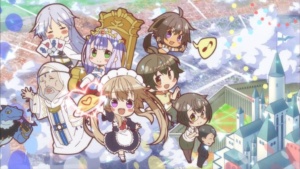 aminoapps.com
aminoapps.comOutbreak Company opens up quite strong, sending a couple of important messages on sensitivity and capitalism that could spark debates. The main character shuts himself away after the girl he liked rejected him. Being an otaku and a shut-in faced with disownment from his parents, Shinichi Kano applied for a shady job targetting people with a wide knowledge of video games, manga, and anime.

He then wakes up in a fantasy world, soon knowing that he now has to propagate Japanese culture to their interdimensional neighbor Holy Eldant Empire. He works together with the, wait for it, Jieitai. Rapidly dominating genre like isekai forces tropes and archetypes to be used again and again. This will make comparisons inevitable – Digimon and Pokemon, SAO and Log Horizon, No Game no Life and Mondaiji.
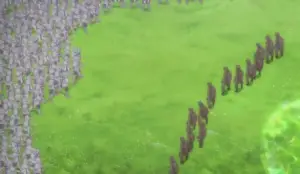
For anime fans, Jieitai is a core part of the Gate: Jieitai anime, it is right there in the title. Both anime uses the following premise: a portal to another world opens up in Japan and it sends its trusty JSDF to explore the uncharted territory. They also work out a peace treaty with the existing kingdom and all goes well. In Gate, that’s basically the entire plot of the first season. In Outbreak Company, the events start a year after the treaty was established.

On a more serious note, Gate appears to be propaganda for bolstering support to Japan’s armed forces. Outbreak Company, on the other hand, throws a slight but serious shade to multiple flaws in mankind. Shinichi works to export Japanese manga, anime, and video games to Eldant. When he resisted at first, the series reveals that he does not know how to return and won’t be able to unless he complies. While his task should foster culture-sharing between the two nations, the representative later reveals that the plan is something else. The Japanese government intends to conquer Eldant by way of cultural invasion – crippling them by basically turning them into NEETs and weebs.

Where Gate threw the occasional jab at the other countries, as well as naysayers among their fellow Japanese, Outbreak Company throws smart references to other works and the regular pandering you’d expect from comedy isekai animes. OC is basically a watered-down, slightly-similar-premise to Gate intended to entertain you for most of its run, and perhaps promote the importance of Otakus in a brave new world. However, to viewers with more keen eyes, this series is not all jokes and fan services.
30. Inuyasha: A Feudal Fairy Tale (Sengoku Otogizōshi Inuyasha)

MAL Rating: 7.91
Even twenty years after its first release, Inuyasha still remains among the anime most fans will recommend for first-timers. Its popularity is such that even those who have not seen Inuyasha knows of it. Any middle-aged anime fan in the world has definitely heard about the half-dog demon and the modern schoolgirl in an epic story of adventure and romance in Sengoku-era Japan.

The art style used in the demons make for good storytelling and establishing a strong fanbase. The story begins when 15-year-old Kagome goes from her 90s timeline back to 500 years in the past. In the midst of the confusion, she released Inuyasha and ended up shattering the powerful Shikon Jewel. They then set on an adventure to recover all the shards. The team later grows with a pervy monk, a demon-hunter, and a cute demon fox who serves as the series mascot.

Story-wise, it’s the basic girl meets boy, boy protects girl, girl falls in love and vise-versa. However, Inuyasha throws an interesting twist by introducing a love triangle in the form of Kikyo – Kagome’s previous reincarnation and Inuyasha’s first love. How do you even choose if they’re essentially the same person?

These points make Inuyasha a well-rounded anime with equal parts humor, suspense, drama, romance with small gore thrown in for good measure. Fans have different opinions with its filler arcs across its 167-episode run. Some find them tedious while some appreciate the occasional break from their main adventure.

The fillers serve a wide variety of purposes which further help make the anime the complete experience that it is. From Shippo’s cute and funny challenge to Izumo’s disappointing, yet sad story. In the end, these are optional parts that try to add flavor to the main series. For those looking for a streamlined experience, check out this filler list from Anime Filler List (yes, it exists!) and spare yourself the extra episodes.

Overall, Inuyasha remains an enduring anime with a fanbase even after long it has ended. It has a well-rounded cast of characters – standard shonen main (like Gon, Naruto, Luffy, etc), to kickass female leads (Kikyo/ Kagome). There’s also a nice story, excluding fillers of course.
31. The Twelve Kingdoms (Juuni Kokuki)

MAL Rating: 8.10
Most of the entries in this list adapt light novels. These are usually short and illustrated to cater to younger audiences. The Twelve Kingdoms, however, is based on regular lengthy novels – an entire series of them. Also, the anime adaptation started ten years after the first novel was published- the novels started back in 1992 while the anime aired in 2002.
The saga centers around a redhaired Japanese student Yoko Nakajima who was abducted by Keiki. The man is actually a holy protector being of one of the twelve kingdoms. She goes to an alternate world reminiscent of Japan and China.
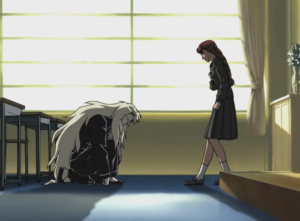
Youko starts out in the other world always crying, feeling helpless, and desperate. The citizens of Kou, where she first lands in, even tricks and betrays her multiple times. These experiences start to harden her up as she learns to fight for her life, and later on, the kingdom she will inherit.
It does not fall into most anime by preaching lessons such as courage or perseverance. You will ask yourself a couple of times if you would react the same way Youko does. The changes in her personality also affect the people around her.
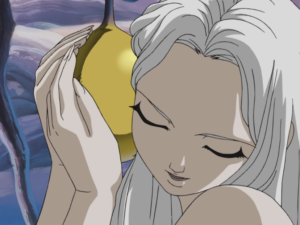
And yes, it does get expository at times, with the kingdoms introduced eventually and the same goes for most of the characters. Juuni Kokki might get some adventure-loving fans who need their regular dose of action, it goes to take at the kingdoms through the eyes of its people – asking important questions in the process.

For example, aside from Youko, there are two other women whose stories are told in the series. Shouko is a spoiled princess forced to live as a commoner after his father was deposed. We also have Suzu, a girl from the Meiji era also trapped in the Twelve Kingdoms. They were all faced with inequalities of a hierarchical society, much more so because they were women. However, regardless of their origin or position, they were able to bring about great changes. Women of different backgrounds and eras direct the course of history at every turn. From Cleopatra, to Wu Zhetian, to Marie Curie, the list is as old as mankind itself.
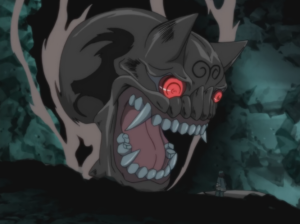
Most of the characters also offer something to the viewers and not just stationary items to move the story forward. Honestly, it feels like a historical epic at times rather than your run of the mill isekai anime.
32. Blood Lad (Buraddo Raddo)
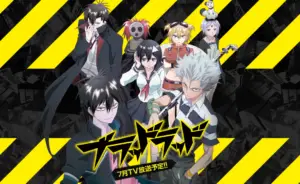
MAL Rating: 7.44
Depending on your religious or philosophical inclination, Blood Lad may either be an isekai anime or not. Regardless, it is definitely a fun anime to watch. Its protagonist, Staz, is a modern-day vampire obsessed with anime and merchandise from Japan. Meanwhile, an average human girl, Fuyumi, stumbles to their demon world. When she dies, Staz decides to resurrect her and thus begins their interesting adventure together.

They will travel around the demon world in search of clues to return Fuyumi to life. This takes them to werewolves and other vampires, and shapeshifters and teleporters. Staz’s obsession with the Japanese culture is thrown as a running gag. Surprisingly, it works well and makes it relatable to almost everyone.
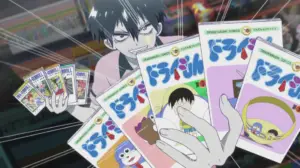
Those who grew up watching anime will definitely have fun watching the series and finding little nods to other anime series. Staz imitating the Kamehameha or getting in a big dipper pattern a-la-Kenshiro from Fist of the North Star is sure to make you laugh.
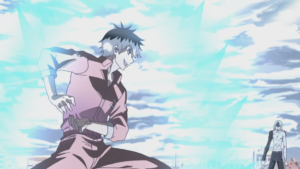
Aside from simply making short quips about other popular fighting anime, Blood Lad stands to be a respectable entry itself. If you have seen fight scenes from Dragon Ball Z or Recca no Hono take weeks, you must be familiar with the standard problem with fighting anime – pacing. Blood Lad saves you the hassle by resolving visually impressive fight scenes in like two or three episodes.

33. Re: CREATORS
MAL Rating: 7.62
Usually, it’s someone from our world going into the fantasy world. It may be inside a novel, game, or anime, or something else entirely. In the event of reverse, it usually turns out to include some fish-out-of-water comedy. Re: Creators skips all that and gives us a strong action drama with some cool effects and fight sequences.

Young high school Souta Mizushino is an average anime fan and student. As he watches his anime-adapted-from-a-light-novel, he goes into the battle of the shoujo main. Surprisingly, a yet-unnamed character wishes to destroy “the world of the creators.” A battle of different characters pulled from various manga, anime, light novels, and music videos soon follows.

The basic premise of Re: Creators is that we live in a higher plane of existence. Every piece of literature we have is a different world in itself. The variety of media that serves as the origin of the Creations opens infinite possibilities. Even the character designs give off that vibe. We find a redheaded girl with a mech (not Asuka). We also have an idol-like character to large mecha with young pilots (not Gundam). It creates a good roster of characters with fleshed-out backgrounds.

It does have a gut-wrenching moment. Later on, it explains the origin of what set off the events of the story. The turn of events then force Souta to face his demons and admit guilt. Even the Military Uniform Princess almost appears human and reasonable. This is emphasized in the last episodes where she met her maker. These points in the series are enough to break your heart. Although it ends well and most creations go back to their respective worlds, not everyone makes it through, much less return.

34. Bofuri: I Don’t Want to Get Hurt, so I’ll Max Out My Defense (Itai no wa Iya nano de Bōgyoryoku ni Kyokufuri Shitai to Omoimasu)
MAL Score: 7.57
This is a surprisingly good entry. We’ve had a lot of VRMMO-type of Isekai. Starting with SAO, it feels like the standard has been set and newcomers just can’t measure up to them. With Bofuri, however, it took a different course which probably led to it being loved by a good share of the audience.
With Isekai anime titles getting longer and longer by the season, we’ll just keep on calling it Bofuri. Kaede Honjou is a VRMMORPG player who, for some reason, doesn’t want to get hurt. So, she created a shield user and maxed out her defense stat – AND ONLY HER DEFENSE STAT. In return, she has no magic damage, moves quite slowly but in return, takes no damage from almost all enemies. She goes on adventures and accomplishes quests.
Technically speaking, it works as a VRMMO anime by not focusing much on the workings of the world as a video game. Remember SAO, Log Horizon, and even Overlord? Bofuri works minimally with the “tutorial” phase and starts immediately with world building and the adventure. Furthermore, as a walking fortress, most of the fun in this series comes from the way she solves challenges and earns achievements by only using her high defense stats in weird yet creative ways. Without physical damage, without magic, without speed, she manages to win in the fight she and her party gets in. If you want to know how she does it, we both think there’s no other way to find out, is there?
35. Cautious Hero: The Hero Is Overpowered but Overly Cautious (Kono Yuusha ga Ore Tsuee Kuse ni Shinchou Sugiru)
MAL Score: 7.52
Cautious Hero is as advertised, a hero who is abnormally cautious. It starts out mostly like any other isekai anime, the hero summoned to another world, gets a mission, you know the works. However, if you’re an RPG player at some point in your life, you can’t really disagree with his methods.
In this anime, we first meet a newbie goddess tasked with saving the world of Gaeabrande from the Demon Lord that dominates it. She then summons the best contender based on stats she sees. However, the hero she summons, Seiya, is ridiculously and overly cautious. Seiya insists on grinding to higher and higher levels before facing even the weakest enemies, with his grinding sessions infuriating Ristarte the goddess. Even worse for Ristarte, Seiya is a smart mouth whose tactics actually work, so the series progresses with her having less and less of a choice but to agree with the overpowered hero.
If I were in Seiya’s position, I’d be very much working the same way he does. Sure it looks more heroic and awesome and rewarding to fight evil in a faceoff of life and death. But when there’s the risk of actually dying, and when people might die, you have to start moving more cautiously. They fight the weaker enemy 1 over and over again until they level up and can fight slightly stronger enemy 2 with the same ease as they did with the first one.
I might be reading too much into the implications, especially since it goes rather lightheartedly about this fact. It even makes it the running joke in the series. I’d advise you to watch it yourself and see if you’d agree.
36. The Ambition of Oda Nobuna (Oda Nobuna no Yabou)
MAL Score: 7.45
No, I think this is not a time-travelling anime. I just want to put it out there. It’s a video game isekai just like any other in the genre. Also, it might get confusing towards fans. This is a video game isekai where the game is inspired by real-world events, and one that I’ve played before. But the events of this video game isekai apparently affect the events of the protag’s own world. Does that make sense? No? Yeah, me too.
In this anime, high school student Yoshiharu Sagara suddenly found himself in the middle of a Sengoku era war. He was saved by Toyotomi Hideyoshi, who dies in his place, unfortunately. As history changes due to this event, Yoshiharu tries to correct history but finds a lot of inconsistencies from what he knows. One of them being this world’s Oda Nobunaga is a woman, Nobuna Oda, who soon becomes his master. He becomes this world’s Hideyoshi and tries to correct history.
While you (and my editors) go on and argue whether it’s actually an isekai anime, I’ll go ahead and tell you to watch this 2012 series. First, it makes an attempt to be inclusive by telling that in this world (isekainess +1), first-born is set to be the family heads despite their gender. It perfectly explains the gender-swapping and fanservice potential. Additionally, it balances action, strategy, comedy, and other harem elements. Check out the video below for a war won without bloodshed.
Other than that, it feels like a female Touken Ranbu, with the usual assortment of female characters. However, while it is mostly comedy, its action scenes are no joke. The various loli waifu are serious sword/ spear/ bow-wielding badasses. Meanwhile, the monkey out of place is understandably weak. But he leverages his knowledge of the game Nobunaga’s Ambition, to great effect. This makes him a valuable strategist since he knows already how history unfolds.
37. Isekai Izakaya: Japanese Food From Another World ( Isekai Izakaya: Koto Aitheria no Izakaya Nobu)
MAL Score: 7.38
I’m not sure whether Isekai Izakaya and Isekai Shokudou are like Calculus – the same thing separately developed by different people. However, I have to say both of them are good, each with its own appeal. It’s something like Cooking Master Boy and Shokugeki no Soma.
This anime focuses on an Izakaya (an informal bar, neighborhood bar), run by Nobuyuki Yazawa and the server Shinobu Senke. Their backdoor is the employee entrance while their front door opens to Aitheria – the capital city of another world. There, they serve Japanese meals to an assortment of guests. They share stories and drinks in a relaxing anime series. Furthermore, it features live appearances from real chefs showing how the flavor of the day is prepared.
It often features exaggerated reactions of wonder to the food, but not to the extent of Shokugeki. This is more of an ASMR kind of anime, relaxing to watch and mouthwatering to follow. The background of the Izakaya remains to be explored, but it does a good job so far. Unlike Isekai Shokudou, the Isekai Izakaya is connected to only one other world. This makes the anime an introductory series to Japanese cuisine aside from the traditional foods we see elsewhere. For a good series on good food, this doesn’t fall behind Shokudou. Plus, the music also contributes to the overall feel – something relaxing and cutesy and all that.
38. Dog Days
MAL Score: 6.94
Dog Days is one of those anime series that reminds you never to judge a show too quickly. Released in the same year as titans like Steins; Gate, Ao no Exorcist, or Sekaiichi Hatsukoi, Dog Days didn’t make as big an entrance as its contemporaries. However, as the weeks went on, it proved itself to be a good watch.
Shinku Izumi has been summoned into the world of Flonyard. It is a lot like Earth, except for people having animal ears and tails. He soon learns that he’s summoned as a hero to protect the Biscotti Republic from the Galette Lion Dominion. Here’s the catch: wars in this world are also unlike ours. There are rules and no casualties, with the “games” betting on lands and resources.
At the onset, it felt like a watered-down No Game, No Life. However, its premise is different and its storytelling does not involve trampling the dignity of humans (or Imanity, in NGNL). Try it and you’d like how it wraps up neatly for the first 13 episodes, no spoilers included. Another point of interest I found is in its exploration of destiny. In Dog Days, there are things characters foresee and try to avoid. But in their effort to avoid them, they inevitably lead to the future they try to avoid. How Masaki Tsuzuki – the creator of Magical Girl Lyrical Nanoha – weaves the story to this effect is a must-see in itself.
Other Series You Might Want to Check Out
39. In Another World With My Smartphone (Isekai wa Sumātofon to Tomo ni)
MAL Rating: 6.55

In literature, we know God as someone who occasionally mixes things up. Sometimes he grants people wishes and sometimes kills people by accident. Fifteen-year-old Touya Mochizuki is one such case. God resurrects him as an apology but in another world. As an added perk, he gets to bring with him his smartphone modified to keep working for him.

Touya is already a kind, benevolent, forgiving person even during his first death. He is basically a divisive main among fans. He appears too kind, others find him bland. Others find him a worthy God candidate, even more, when he manifested his powers.
Lastly, as an anime with the smartphone in the title, he could use it a little bit more. In fact, the author of the light novel recognized this weakness, apologized, and improved later on.
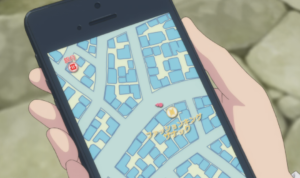
For serious fans of the genre, this is not a recommended watch. Generic tropes found across every other anime fill the series to the brim. The anime drives the cliches of the isekai genre to a corner. Almost all cliches fill its twelve-episode run. For fans looking for the genre’s metaphorical kick in the balls, this is a good find. As Redditor u/DoctorWhoops said, “So unnoteworthy that it in itself becomes noteworthy for its unnoteworthiness.”
40. Arifureta: From Commonplace to World’s Strongest (Arifureta Shokugyō de Sekai Saikyō)

MAL Rating: 6.53
It’s an excellent example, and will remain to be, of how liberally going away from the source material is rarely a good idea. Anime builds the source material’s story and concept. Motion, colors and a touch of CGI brings it to life. This is especially true in the isekai genre. Arifureta skips past that and well, you know the rest.

Arifureta: From Commonplace to World’s Strongest has promising premises. (1) The entire class sent to another world. (2) The main work twice as hard to keep up with the rest. It promptly goes to crash and burn in episode one. It fails immediately because it skips essential parts holding the story together.
Another cause for the sharp criticism it receives from fans and critics alike is the quality of animation. The edge around the characters gives the impression of a poor cut-and-paste job against the background. If anything, the story starts to mellow down in the following episodes. The character development has made some fans stay with the series.

41. Isekai Cheat Magician (Isekai Chīto Majutsushi)
MAL Rating: 5.53
A lot of isekai entries are flooding and dominating the anime scene. The basic premise of getting transported to another world will immediately get old. Most of the successful anime over the years has brought something new to the table. Some anime makes the main character a villain or a bitter victim of circumstances. Others go and throw an entire class to the other world. Isekai Cheat Magician fails to do this. The series cripples it down to the baseline of the ever-expanding isekai genre, and into obscurity.

If you are like us at Chasing Anime, the first letdown was the title itself. Calling them Cheat Magicians opens a lot of mind-bending possibilities. It’s as if they have something only they can do or bend the laws that govern their new world. Instead, we find a pair of highschoolers transported to the other world. After enrolling to learn how magic works there, they find out that they have better magic than anyone else. And that’s it.

It also lacks a lot in terms of storytelling. Aside from the generic storyline, the potential twists reveal itself too early, ruining the surprise. The series tends to disregard character backgrounds too. Anastasia turns from a menacing assassin to a submissive busty girl without explanations whatsoever.

Final Thoughts
So, with so many isekai series out there, it is seriously hard to choose which series to start with. Hence, we present ChasingAnime’s ultimate anime recommendation list that both beginners and veterans alike can rely on. If you’re curious which isekai anime best suits you, take this quiz down below. Share your result in the comments, we want to hear from you!





















































![What does Tanjiro’s black sword mean? [All Nichirin Sword Colors Explained]](https://chasinganime.com/wp-content/uploads/2020/01/Nichirin_Sword-100x70.png)
